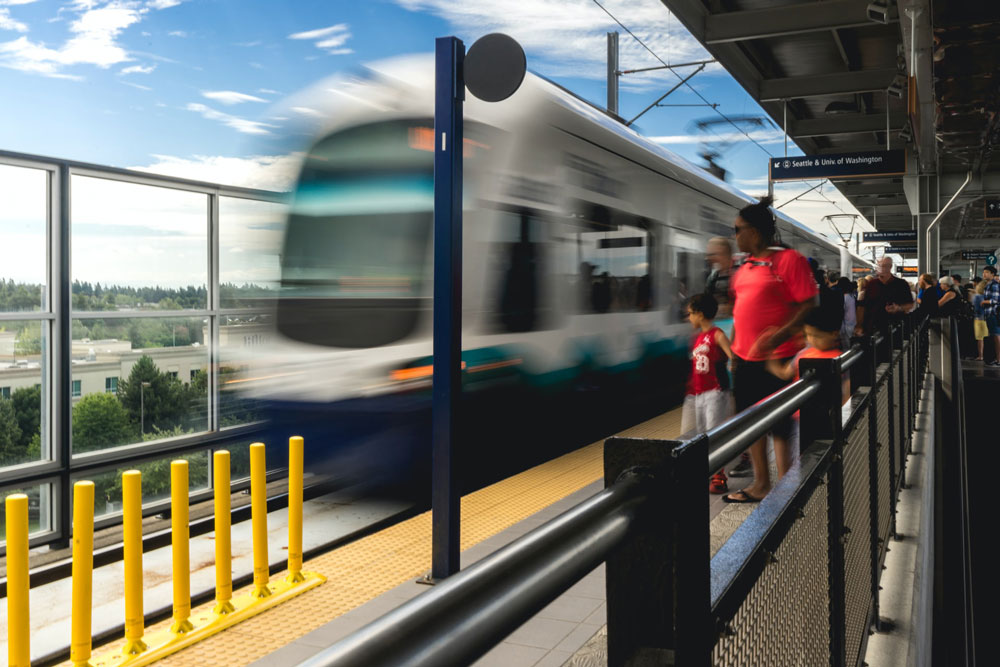“Access to transport is a fundamental right for people in modern society.” - Kevin Orr, Liftango CEO
Having means to access Public Transport provides a way for people who do not have access to private motorised transport a way to access essential services, as well as employment, entertainment and social activities.
Why is access to transport important?
Research has found positive impact on daily societal activities, the environment, socio-economic factors and on health because of Public Transport provisions. Let’s look at six reasons why access to Public Transport is so important in both urban and rural contexts.
1. Public Transport is better for the Environment
It’s no surprise that Public Transport is a far better option for the environment than private and Single Occupancy Vehicles (SOV’s).
29% of global emissions is attributed to transportation usage. In 2018, The Environmental Protection Agency stated that 41% of Greenhouse Gases caused by modes of transport were emitted by cars. Car usage continues to have detrimental effects on the environment and creates unnecessary road congestion. Of this, cities are major contributors to these problems, said to emit more than 70% of all emissions.
Rural areas in particular are faced with transit challenges when it comes to convenient access to transport services, which is why car usage is so much higher compared to urbanised communities. For example, UK data shows that over 50% of families in rural communities own two or more cars. Consequently, SOV usage heightens—as does C02 released.

Yatskiv et al. states that access to mobility through Public Transport provides a way to decrease damaging effects on the environment resulting from car usage, by instead promoting environmental healthiness. When communities with strong Public Transport systems utilise their facilities, the Center for Climate and Energy Solutions (C2ES) predicts that up to 37 million metrics tons of carbon emissions could be reduced yearly.
2. Public Transport Creates Social and Financial Equity
Social and financial equity continues to play a large role in how accessible resources are to individuals and families.
Because Public Transportation creates social opportunity for members of the community who may not have access otherwise—it remains an essential and vital service for society. Being able to easily and conveniently access public modes of transport effectively heightens and promotes positive mental health and a sense of belonging through social connection. Loneliness and isolation can be combated when access to social-related services are heightened through affordable transit initiatives.
Public Transport also can be a much more affordable option for individuals or families who are unable to purchase and upkeep the cost of a vehicle or pay for private ridesharing services. Taking advantage of Public Transit is also much better for our wallets in general. In particular, the elderly are less likely to have disposable incomes and may need to rely on Public Transport as ageing occurs.
As time goes by, the elderly are less likely to own vehicles and therefore having availability to transit is imperative for an ageing population. Students and young adults who have limited access to financial resources (because incomes are typically lower on the earnings scale) are also another community group more reliant on Public Transport systems as it provides one of the most affordable means of connecting to essential services and broadening their scope for opportunity.
When access to Public Transport is restricted or unavailable for particular community groups, their social and financial equity is put at risk—especially for families with limited incomes, the elderly and students.
3. Public Transport is better for our health
There is a direct correlation between physical activeness and the utilisation of Public Transport.
The UK Department of Transportation revealed in 2016 that trips less than one mile are 81% more likely to be taken on bike or foot, in contrast to 80% of trips are taken via car when more than two miles away. Physical activity is heightened and it is apparent that people are more likely to walk a distance to get to a destination (including a bus stop, train station etc) if geographically closer and available.
Capena also highlights how Public Transport Planners tend to take into consideration that people are in general willing to walk up to 400m for buses and 800m for rail transport.

Incidental exercise (incremental movements we make and build up throughout the day) is another great benefit of using Public Transport, because of the smaller distances travelled to move from one transit hub or meeting point to another. When compared to utilising a car—unless the individual needs to park further away from the destination and walk—incidental exercise is replaced with the convenience of arriving a few steps away from the final destination.
A 14.5 year long study in the year of 2000 in Copenhagen, Denmark found that bicycling (on average 3 hours weekly) to work decreased risk of mortality approximately by 40% (after multivariate adjustment, including leisure time physical activity) compared to those who did not commute via cycling.
Evidently, exercise is crucial for a higher quality of life, and by equipping society with the tools to incorporate convenient exercise as part of a regular commute, the use of Public Transport becomes a great way to combat health complications and obesity when incidental exercise occurs.
4. Public Transport provides access to Employment
A lack of access to adequate transportation becomes a huge employment barrier—especially for individuals who do not have access to private vehicles. Opportunity for employment is therefore heightened when Public Transportation is readily available, convenient and affordable.
According to Pons Rotger and Nielsen, the assistance of commuting options available in urban public transport systems, helps improve individual performance on the labour market—because of the possibilities these individuals have in accessing a workforce full of plentiful opportunity.

However where transport is lacking, disadvantages are prominent for those in society who need access to transit services to access employment opportunities. These transport services should be designed to ensure that employment opportunities are not diminished because of an individual's geographic location or their socioeconomic status.
A cycle of unemployment or employment disadvantage is faced when communities can’t access the opportunities they need to rise out of current circumstances. A 2019 literature review by Saif et al., explains that Public Transport based job accessibility reflects positively on individual incomes.
The UK 2010 Child Poverty Act also states that:
“Transport infrastructure, and accessibility to local services for children and parents, and employment opportunities for parents, are important in all local areas and are likely to be particularly so for those living in more remote or rural areas where the effects of growing up in poverty may be compounded by poorer access to services."
Rural and remote areas are at further risk of facing disadvantage when it comes to employment opportunities should Transport infrastructure be less accessible. Hence Public Transportation serves as vital importance in providing access to employment.
5. Public Transport Combats Social Exclusion and Transport Disadvantage
A lack of access to transportation services is proven to contribute to social exclusion.
“...people are prevented from participating in the economic, political and social life of the community because of reduced accessibility to opportunities, services and social networks, due to whole or in part to insufficient mobility in a society and an environment built around the assumption of high mobility" - Kenyon et al.
Literature on the topic reveals how transport disadvantage continues to threaten many aspects of life—from economic, physical, psychological and social—because of inadequate transportation services.
This is particularly prominent with elderly community members, with results from an Austrian study comparing mobility patterns among 15 transportation disadvantaged groups, revealing how many difficulties in part stemmed from lacking transit services. Barriers to mobility include time taken to reach and environmental surroundings in accessing Public Transport, the location of pick up and drop off points and the design of vehicles (including physical limitations to get on the service).
If transport disadvantage becomes a reality for elderly community members—a loss of freedom is therefore presented and negative physical and mental health consequences can stem from this. Thus, in order to maintain a high standard of physical, mental and social health of an ageing population, it's imperative that transport services are providing adequate access to transport to not only the elderly, but the overall community in order to combat any essence of social exclusion.
6. Public Transport enables mobility
In order to sustain a higher quality and standard of life, communities need access to vital services that will ensure the upkeep of physical and mental health, employment opportunities, social and leisure activities.
When convenient mobility is not available to a community, there is a high dependence on cars and this may either create a financial burden on families/individuals or disqualify community members in being able to access essential services at all.
Kate Ascher in her book ‘The Works: Anatomy of a City’ states that:
“ mobility is a key condition of access to employment, housing, education, culture and leisure and family. The right to work, to have a home, to training involves the right to mobility... in a sense this right to mobility is a precondition of the other rights."
Without the right to be mobile and access services, everything else falls short. Financial pressures are heightened, and community members without mobility can find themselves at risk of getting into a cycle of struggle without accessing support or essential services conveniently.
The answer is Public Transport.
Public Transport paves the way for mobility—particularly for those who don’t have a mobility alternative.
What happens when there’s a lack of access to transport?
When there is a lack of access to transport, quality of life is highly compromised and social exclusion is at risk for those dependent on Public Transport. According to a study by Lättman et al., having a perceived access to transportation is also a measure of satisfactory living for Public Transport users.
The elderly are particularly vulnerable and are in need of transport that caters to health needs in an affordable manner. When freedom is taken away from the elderly, quality of life is at risk of diminishing and mental health risks heightened.

Public Transport is an enabler, and when this enablement is taken away from individuals within society who depend on it, councils and governments risk sending their citizens on a negative trajectory with multifaceted consequences.
Consequently, key findings from Saghapour et al. state that providing accessible and efficient public transport should be one of the main objectives of policy makers and planners in metropolitan areas throughout the world.
Why equitable transport systems need to be put in place
Equitable transport systems need to be put in place in order to allow community members who have a reliance on public transport systems to access them with ease, and to encourage those who may not be dependent to integrate Public Transit into everyday life because of the associated positive benefits.
Public Transport not only enables community—it embodies it. Governments and councils need to not just preserve, but enhance their transit systems as the world continues to change. And in order to frame Public Transit in an attractive light, access to transport data and improved simulation capability comes into play. This enables Government Agencies to enhance the way they provide traditional transit modes to the community.
Providing door-to-door service and more flexible access for those travelling longer distances is a gap we must fill. Data produced by an ageing population coupled with younger generations seeking employment opportunities show us why access to transport is so important.
This is where implementing technology like Demand-Responsive Transport (DRT) as part of a Transit Agencies product offering will seek to benefit the community. DRT conveniently connects members of society with the services they need. It also provides Transit Agencies with a way to optimise operational costs and improve their infrequent and underutilised fixed-route services.
Removing barriers to access Public Transport is a modern right. In both an urban and rural context—when it comes to promoting sustainability, mobility, physical and mental health and combatting transport disadvantage, accessibility to Public Transport is key. Technological advancements are here to help make Public Transportation systems more effective and affordable than ever before—now is the time for Transit Agencies to be proactive, not just reactive to the needs of their communities.
%20(1).jpg)
